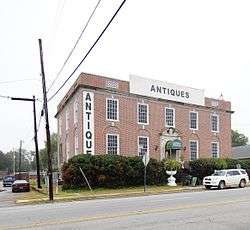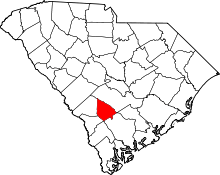Denmark, South Carolina

| Denmark, South Carolina | |
|---|---|
| City | |
| Nickname(s): City of Pride | |
| Coordinates: 33°19′16″N 81°8′32″W / 33.32111°N 81.14222°WCoordinates: 33°19′16″N 81°8′32″W / 33.32111°N 81.14222°W | |
| Country | United States |
| State | South Carolina |
| County | Bamberg |
| Government | |
| • Type | Mayor-Council-Commission |
| • Mayor | Gerald E. Wright |
| Area | |
| • Total | 3.84 sq mi (9.94 km2) |
| • Land | 3.83 sq mi (9.93 km2) |
| • Water | 0.004 sq mi (0.01 km2) |
| Elevation | 240 ft (73 m) |
| Population (2010) | |
| • Total | 3,438 |
| • Density | 922/sq mi (356.1/km2) |
| Time zone | Eastern (EST) (UTC-5) |
| • Summer (DST) | EDT (UTC-4) |
| ZIP code | 29042 |
| Area code(s) | 803 |
| FIPS code | 45-19105[1] |
| GNIS feature ID | 1247519[2] |
Denmark is a city in Bamberg County, South Carolina, United States. It is estimated that the population is at 3,458 currently (2017).
Geography
Denmark is located in northwest Bamberg County at 33°19′16″N 81°8′32″W / 33.32111°N 81.14222°W (33.321173, -81.142289).[3] U.S. Route 78 and U.S. Route 321 cross in Denmark just north of the downtown area. US 78 leads east 6 miles (10 km) to Bamberg, the county seat, and west 8 miles (13 km) to Blackville. US 321 leads north 9 miles (14 km) to Norway and south 7 miles (11 km) to Govan.
According to the United States Census Bureau, the city has a total area of 3.8 square miles (9.9 km2), of which 0.004 square miles (0.01 km2), or 0.09%, is water.[4]
Demographics
| Historical population | |||
|---|---|---|---|
| Census | Pop. | %± | |
| 1890 | 366 | — | |
| 1900 | 724 | 97.8% | |
| 1910 | 1,075 | 48.5% | |
| 1920 | 1,254 | 16.7% | |
| 1930 | 1,713 | 36.6% | |
| 1940 | 2,056 | 20.0% | |
| 1950 | 2,814 | 36.9% | |
| 1960 | 3,221 | 14.5% | |
| 1970 | 3,571 | 10.9% | |
| 1980 | 4,434 | 24.2% | |
| 1990 | 3,762 | −15.2% | |
| 2000 | 3,328 | −11.5% | |
| 2010 | 3,538 | 6.3% | |
| Est. 2016 | 3,546 | [5] | 0.2% |
| U.S. Decennial Census | |||
As of the census[1] of 2000, there were 3,328 people, 1,331 households, and 846 families residing in the city. The population density was 1,096.0 people per square mile (422.7/km²). There were 1,537 housing units at an average density of 506.2 per square mile (195.2/km²). The racial makeup of the city was 85.91% African American, 12.74% White, 0.09% Native American, 0.51% Asian, 0.06% from other races, and 0.69% from two or more races. Hispanic or Latino of any race were 0.75% of the population.
There were 1,331 households out of which 29.8% had children under the age of 18 living with them, 30.2% were married couples living together, 27.5% had a female householder with no husband present, and 36.4% were non-families. 32.0% of all households were made up of individuals and 11.7% had someone living alone who was 65 years of age or older. The average household size was 2.47 and the average family size was 3.15.
In the city, the population was spread out with 26.8% under the age of 18, 9.7% from 18 to 24, 24.7% from 25 to 44, 24.1% from 45 to 64, and 14.7% who were 65 years of age or older. The median age was 36 years. For every 100 females there were 85.6 males. For every 100 females age 18 and over, there were 82.6 males.
The median income for a household in the city was $17,578, and the median income for a family was $22,346. Males had a median income of $22,110 versus $13,767 for females. The per capita income for the city was $11,243. About 33.4% of families and 35.2% of the population were below the poverty line, including 51.9% of those under age 18 and 30.8% of those age 65 or over.
History
Denmark was originally called Grahams Turnout, and under the latter name was founded in the 1830s when the railroad was extended to that point.[6] The present name is for B. A. Denmark, a railroad official.[7]
Historic sites
The American Telephone and Telegraph Company Building, Denmark High School, and Voorhees College Historic District are listed on the National Register of Historic Places.[8]
The Dog Wood Festival
Denmark is home to the Dog Wood Festival, which is a festival that includes rides, games, and food/drink stands and is usually hosted 517.01 ft (15758.4648 cm [estimated]) from Beech Ave to South Beech Ave. According to the history of the Dog Wood, it first began in the year of 1985 and still goes on once a year. Not only is there a festival, but also a parade to get it started. This all happens near the month(s) of March on a sunny day. This doesn't only have the festival area to affect, but more.
Each year of the festival visitors region-wide come to Denmark for the festival and usually stops by one of Denmark's retails and restaurants before or after going to the festival. This has a good affect on the money made. A restaurant like McDonald's casually has an average of 14 cars located on the property, but on a day like the festival the car population gets boosted by a 41.32 percentile.
Transport
Amtrak, the national passenger rail system, serves Denmark, operating its Silver Star daily in each direction, between Miami, Florida by way of Tampa, Jacksonville, and Savannah, and New York, New York by way of Columbia, Richmond, Washington, and Philadelphia.
Education
Notable people
- Jim Harrison - artist, author, speaker
- Cleveland Sellers
- Bakari Sellers
- Woody Binnicker, businessman, former mayor, established the first Endurance Parachute Record, making 201 parachute jumps in 17 1/2 hours in February 1973[9]
- Drink Small, The Blues Doctor, jazz musician
- Dr. Jonathan M. Goodman, II - Educator and Inventor
References
- 1 2 "American FactFinder". United States Census Bureau. Archived from the original on 2013-09-11. Retrieved 2008-01-31.
- ↑ "US Board on Geographic Names". United States Geological Survey. 2007-10-25. Retrieved 2008-01-31.
- ↑ "US Gazetteer files: 2010, 2000, and 1990". United States Census Bureau. 2011-02-12. Retrieved 2011-04-23.
- ↑ "Geographic Identifiers: 2010 Demographic Profile Data (G001): Denmark city, South Carolina". U.S. Census Bureau, American Factfinder. Retrieved April 2, 2014.
- ↑ "Population and Housing Unit Estimates". Retrieved June 9, 2017.
- ↑ Boman, Roberta A. (Aug 20, 1981). "Railroad gave towns names". The Sumter Daily Item. pp. 6B. Retrieved 28 October 2015.
- ↑ Gannett, Henry (1905). The Origin of Certain Place Names in the United States. Govt. Print. Off. p. 104.
- ↑ National Park Service (2010-07-09). "National Register Information System". National Register of Historic Places. National Park Service.
- ↑ "Woody Binnicker". Ehrhardt SC. Retrieved 2013-09-24.
